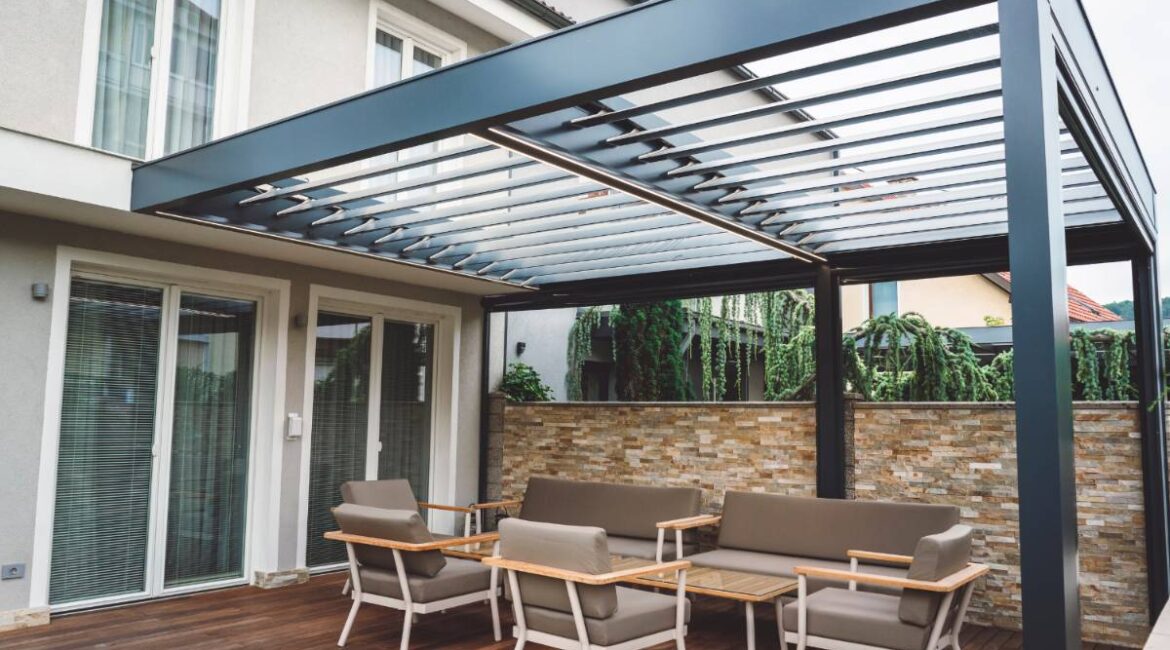Introduction
If you’re looking to add a little shade and privacy to your backyard or simply want to create an outdoor space that looks beautiful all year round, the pergola is an excellent choice. In this guide, we’ll go over all the basics of pergola so that you can make the right decision for your home.
What is a Pergola?
Imagine a delightful alfresco retreat whereby artistically interwoven wooden or metal beams and columns create a pergola. The vertical columns of a pergola support crossbeams, offering shade and elegance in an outdoor architectural masterpiece. It looks great on a patio, deck, or other outside area, or it may be fixed to a structure or left alone in a garden. With their many hats, pergolas provide shade for lounging, provide visual interest to gardens with climbing plants and vines, and serve as outdoor spaces for entertaining and eating.
Pergolas have open roofs that let soft sunshine and soft breezes caress those below, setting them apart from their architectural relatives, arbors, gazebos, and pavilions. Be it a comfortable hideaway or an elegant addition to your outdoor oasis, the adaptable pergola is a blank canvas waiting to be customized. Italian “pergola,” which denotes a wooden structure, is where the word “pergola” originates. Choose from wood, stone, or metal to create a timeless garden element that will complement your specific design and offer character, a hint of romance, and a feeling of harmony.
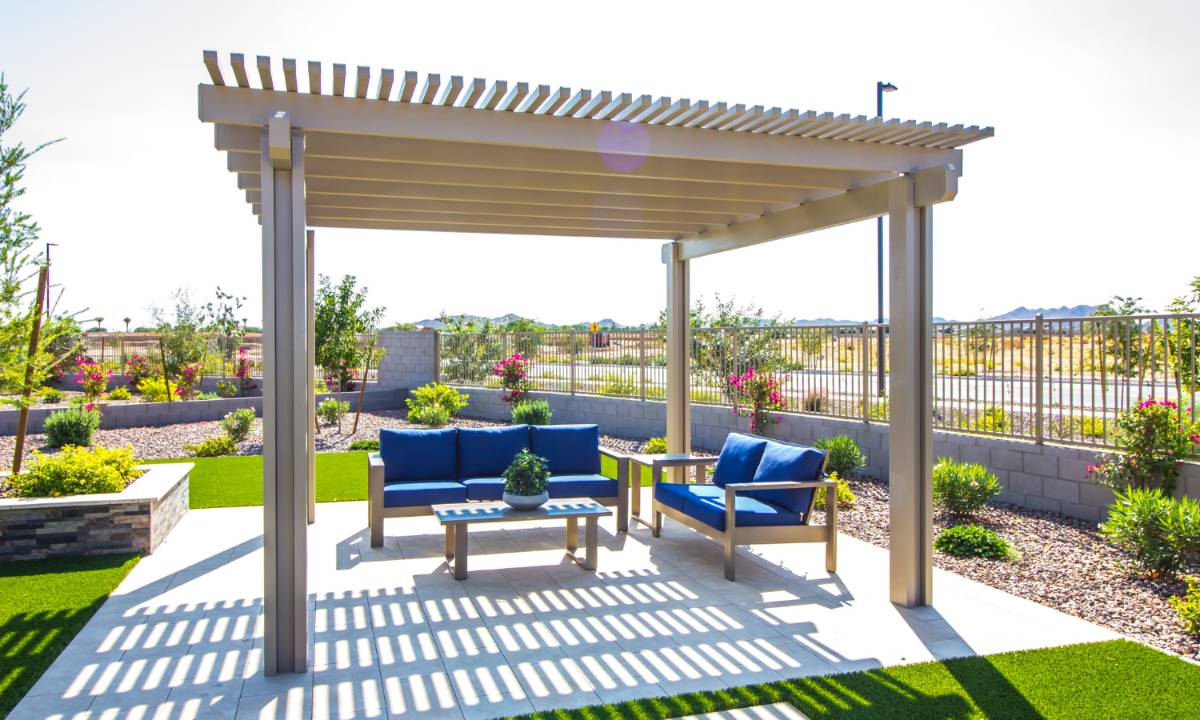
The History of Pergolas
It was in Italy that the name “pergola” first appeared, signifying an arbor covered in vines that served as a grape canopy. As more time passed, its meaning expanded to include any building that could provide such shelter from the elements. With a centuries-long history dating back to ancient Egypt, pergolas were also popular with the Greeks and Romans. These early pergolas provided shade from the sun and acted as garden havens, embellished with vines. Their function and design changed over time. They grew increasingly elaborate throughout the Renaissance, and in the 18th and 19th centuries, they were widely accepted as garden accents across Europe.
Pergolas are used for both practical and aesthetic purposes nowadays. They provide shade, designate outdoor areas, and present the best locations for outdoor get-togethers and leisure. Pergolas are made from a variety of materials, including metal, vinyl, and wood, and they may be designed in a variety of ways to match different architectural styles. Customization is made possible by additions like cloth canopies and climbing plants, which result in unique and cozy outdoor areas. In conclusion, pergolas have a fascinating history that shows how they changed from their utilitarian beginnings to become timeless and adaptable components of contemporary landscape architecture.
Uses of Pergolas
There are lots of uses for pergolas in outdoor areas. The main uses are as follows:
- Sunlight shade: They offer a chic refuge from the sun and shade. You can comfortably enjoy being outside.
- Aesthetic Appeal: Pergolas give patios and gardens a charming architectural element. They add visual appeal to your landscape.
- Support for Climbing Plants: Because of its open structure, climbing plants can easily be supported. Imagine a lush canopy made of fragrant roses and colorful vines.
- Outdoor Functionality: Pergolas serve as a defining feature for outdoor living spaces. They improve outdoor functionality and are wonderful for dining and relaxing.
- Privacy: They serve as barriers to privacy. They provide privacy and peace when draped with curtains or lattice.
- Enhancement of Property Value: Masterfully designed pergolas raise the value of a home. They entice prospective purchasers.
Pergolas can be customized to fit a variety of environments. They combine functionality and form. They enhance landscapes with beauty and usefulness. Outdoor areas are cozier and cozier with pergolas.

The Types of Materials Used to Build a Pergola
A pergola is an excellent addition to any backyard. It provides additional space for you and your family to relax and enjoy the outdoors while providing shade from the sun. If you are planning on building or buying a pergola, then it is crucial that you know about all of the different materials that can be used to make sure that you get precisely what you want for your home.
The most popular material used when building a pergola is wood because it looks great but also lasts longer than other types of material such as steel or concrete due to its natural durability over time. Some people might opt not to use wood because they fear insects getting inside their house through holes made by termites eating away at wooden beams supporting up against walls running vertically along lengthwise sides; however, there are many ways around this problem, such as installing insecticides into crevices first before construction begins so nothing gets inside where they could nest later down the line after construction finished (which may require extra work).
Another option would be using stainless steel instead because high-pressure treated lumber cannot withstand long periods of fully exposed sunlight without becoming brittle; however, very few companies produce these types of products, with prices usually exceeding $10k or EGP 310K per linear foot.
Related: 41 Different Types Of Pergolas – A Comprehensive Guide
How To Build a Pergola?
Creating your dream pergola is a fulfilling journey, and we’re here to guide you through it. First, let’s outline the essential steps:
- Plan Your Design: Start by choosing a sunny spot in your yard, ensuring it receives at least 6 hours of direct sunlight daily. Design the size and shape, considering the number of columns you desire (typically 4-6).
- Gather These Materials: Collect the necessary materials, such as posts, beams, rafters, and hardware like screws and nails, tailored to your unique design.
- Prepare Your Outdoor Space: Ensure the ground is level and free of obstructions. Dig holes for the posts, ensuring proper spacing.
- Set the Pergola Posts: Secure the posts in the holes using concrete for stability and longevity.
- Attach Beams and Rafters: Install the horizontal beams atop the posts, and then attach the rafters perpendicularly, evenly spaced.
- Optional Roofing: Enhance your pergola with a roof for shade or aesthetics, using materials like lattice, fabric, or climbing plants.
- Finishing Touches: Give your pergola a polished look by sanding any rough edges and applying paint or stain.
- Maintain and Enjoy: Regular maintenance ensures your pergola’s longevity. Add furniture and decor to complete your ideal outdoor space.
Now that you have these steps, you’re all set to embark on your pergola-building adventure, creating a beautiful, functional addition to your outdoor oasis. Enjoy the journey.
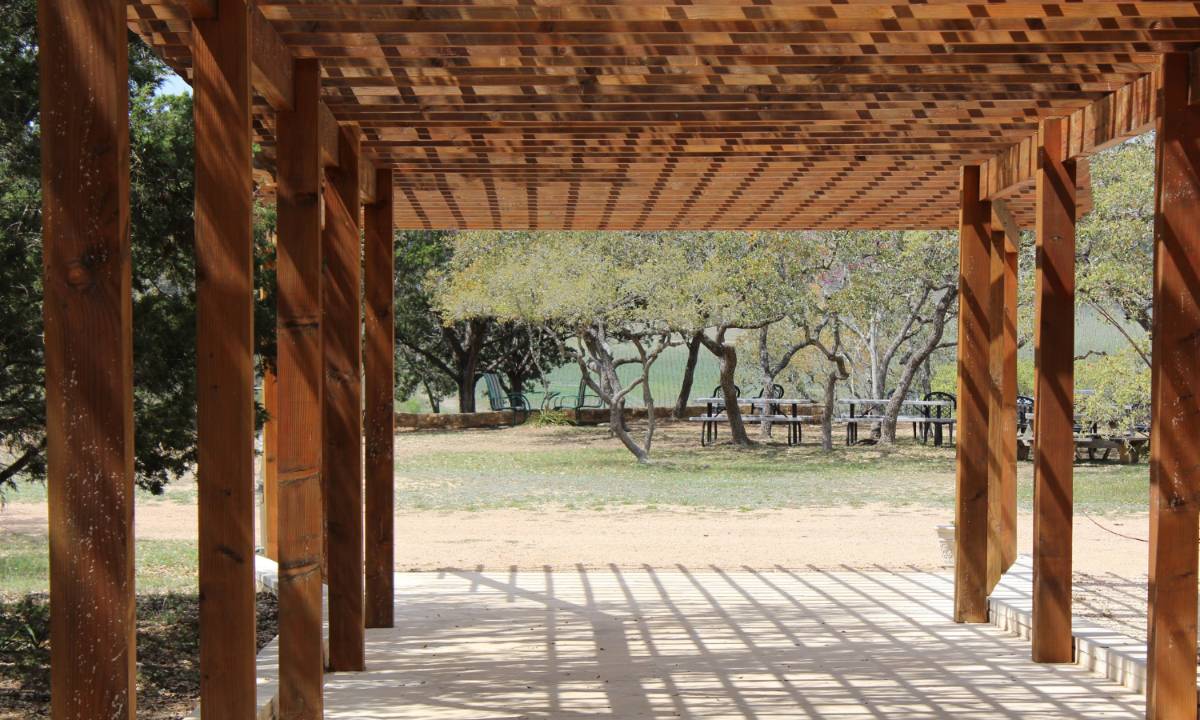
How to Enclose a Pergola?
When it comes to enclosing your pergola, the choices are diverse and adaptable to your specific needs and style. Here’s how you can create a unique enclosure for your outdoor haven:
- Pergola Curtains or Screens: Embrace versatile weather-resistant curtains or screens that offer shade, privacy, and weather protection. Easily roll them down as needed.
- Pergola Roof: For ultimate weather protection, consider adding a solid or semi-solid roof to your pergola. It shields you from rain, snow, and harsh sunlight.
- Pergola Walls: Get creative with wooden or metal frames, shaping walls for your pergola. Add windows or transparent panels for that perfect blend of openness and protection.
- Pergola with Curtains: Enhance flexibility with curtains along the sides of your pergola, allowing you to adapt to changing weather and privacy requirements.
- Pergola Greenery: Infuse nature into your space by planting climbing vines or installing trellises. Watch them grow into a lush, living enclosure that’s both beautiful and breathable.
- Temporary Screens: Keep it adaptable with removable screens or panels for specific seasons or privacy needs. Easily install and remove them as required.
Remember, your choice of materials and design depends on your climate, intended use, and aesthetic preferences. Building a walled and floored enclosure around your pergola is an option, and here’s a quick breakdown:
- Measure your pergola, ensuring it complies with local building codes.
- Designate wall placements and create an accurate design.
- Purchase the necessary building materials from a hardware store.
- Build walls from your chosen materials and customize the look with paint or stain.
- Create the floor by laying down plywood boards or planks.
How to Install a Pergola?
Installing a pergola is a breeze, allowing you to create a charming outdoor space. You can place it on various surfaces like concrete slabs, wooden decks, brick or stone patios, or even against a concrete wall for a touch of elegance. To set up a pergola on a concrete slab, follow these steps:
- Plan and Design: Decide the pergola’s location and size and select materials and design.
- Check Local Regulations: Ensure you comply with any necessary permits or regulations.
- Gather Tools and Materials: Common tools include a saw, drill, hammer, and level, along with posts, beams, rafters, and hardware.
- Prepare the Site: Mark where posts will be placed, dig holes, and add gravel for drainage.
- Install Posts: Set posts in holes, ensuring they’re level, and secure them with concrete or anchor brackets.
- Attach Beams and Rafters: Connect horizontal beams to posts and add rafters evenly spaced perpendicular to the beams.
- Finishing Touches: Enhance aesthetics with decorative end caps and cross beams, then apply stain or paint for protection and style.
- Optional: Attach to a House: For support and shelter, follow specific steps for attaching to your house.
- Maintenance: Regularly inspect and maintain your pergola to ensure its longevity.
With these steps, you’ll be on your way to creating a beautiful and functional outdoor space.
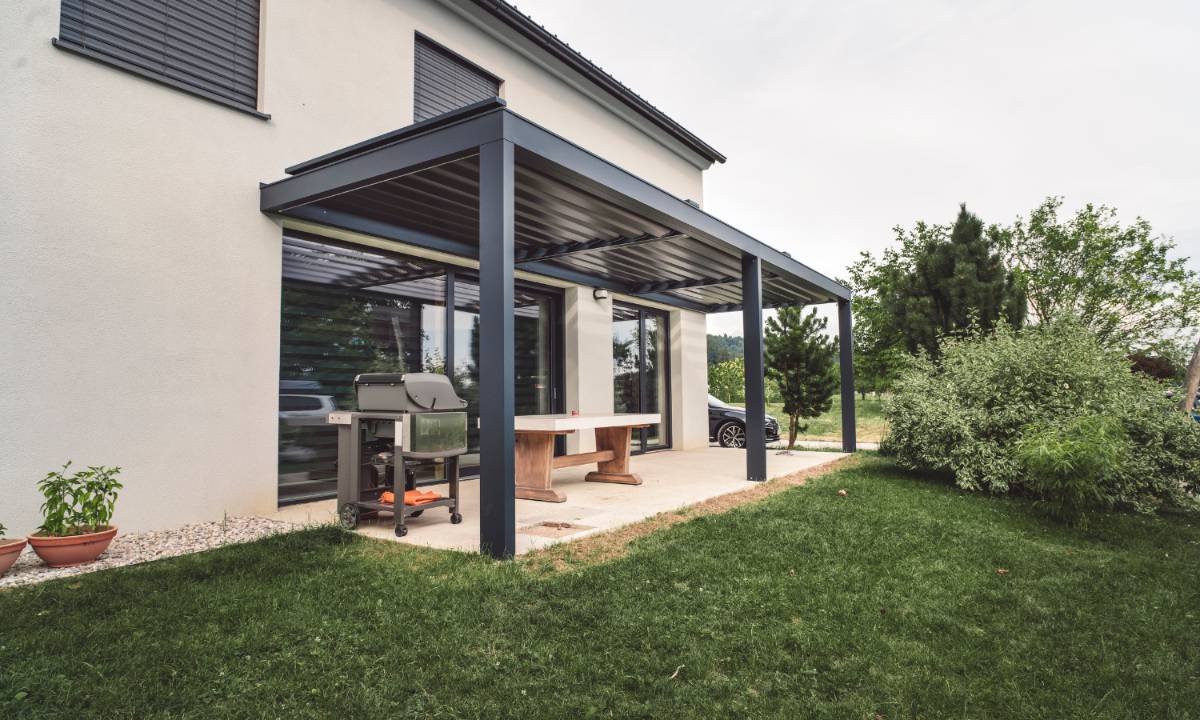
What is the Difference Between a Pergola and a Gazebo?
Let’s start with the basics. A pergola is a roofed structure that sits on columns or posts. On the other side, gazebos are open on all sides and generally freestanding. Professionals often use Pergola to describe any type of covered walkway like an arbor.
When considering outdoor structures to enhance your living space, it’s crucial to understand the distinctions between a pergola and a gazebo:
Design and Structure:
- A pergola is an open, arched structure with an airy, lattice-like roof and no walls, creating an open and inviting atmosphere.
- In contrast, a gazebo stands freestanding, with a closed roof and open sides, offering a more enclosed, defined space.
Roof:
- Pergolas feature an open roof, allowing dappled sunlight to filter through the interwoven beams or lattice, providing partial shade.
- Gazebos have a solid, closed roof that offers complete protection from the elements, ensuring comfort in various weather conditions.
Purpose:
- Pergolas often serve as garden decorative elements, providing support for climbing plants and creating shaded seating areas.
- Gazebos, designed for shelter, offer a more enclosed space ideal for relaxation, dining, or outdoor gatherings.
Versatility:
- Pergolas are highly versatile and can be customized in various sizes and styles to suit your preferences.
- Gazebos come in fixed designs, offering less flexibility for customization.
In summary, while both pergolas and gazebos can enhance your outdoor space, the key differences lie in their design, roof structure, intended purpose, and versatility. Pergolas provide an open, customizable design with partial shade, whereas gazebos offer a more enclosed, sheltered space. So, when planning your outdoor project, consider your specific needs and preferences to create the perfect addition to your outdoor living space.
Related: 33 Creative Backyard And Outdoor Gazebo Ideas
Which One is Better, Gazebo or Pergola?
When it comes to choosing between a gazebo and a pergola, there are some key distinctions to consider:
- Gazebo: These structures offer full coverage with their enclosed roofs, making them perfect for shielding you from the sun and rain during outdoor gatherings. The enclosed design also creates an intimate and cozy atmosphere. Gazebos tend to be on the pricier side due to their solid roofs and additional features like screens or curtains for insect control. They work well as standalones or as extensions of your home.
- Pergola: In contrast, pergolas feature an open, slatted roof that allows sunlight to filter through, offering partial shade and a more open-air feel. People often use pergolas to define outdoor spaces, such as garden paths and patio areas, and they make a great support structure for climbing plants. Pergolas are generally more budget-friendly and highly customizable with various materials and designs.
Ultimately, the choice between a gazebo and a pergola comes down to your preferences and intended use. Gazebos are your go-to option for complete coverage and a snug ambiance, while pergolas provide a more open, cost-effective alternative for partial shade and delineating outdoor spaces. So, whether you opt for the enclosed allure of a gazebo or the open charm of a pergola, both of these structures offer unique and delightful options for outdoor living and entertaining.
Related: The Ultimate Guide To Gazebos
Building a Pergola Attached to House, Roof, or Free Standing?
When contemplating the construction of a pergola, there are three main approaches to consider, each with its own distinct advantages and considerations:
Attached Pergola:
- Seamlessly extends your home, blurring the lines between indoor and outdoor spaces.
- Provides shelter and weather protection for an adjacent patio or deck.
- Requires proper structural attachment to the house, potentially involving structural adjustments.
- Limited flexibility in terms of placement and size.
Pergola with Roof:
- Offers year-round protection from rain, sun, and various weather conditions.
- Can be designed with adjustable louvers or retractable canopies for versatility.
- Introduces added cost and complexity due to the roof structure.
- May necessitate permits due to the increased structural load.
Freestanding Pergola:
- Grants more design flexibility and diverse placement options in your outdoor space.
- Easier to construct with fewer structural concerns.
- Lacks the seamless integration with your home.
- Provides limited protection from the elements.
Your choice depends on your specific needs, budget, and the layout of your outdoor space. It may be beneficial to seek guidance from a professional tailored to your unique situation. If you desire a pergola closer to you but separate from your house, a rooftop pergola could create the privacy and elevation you seek, though additional roofing costs may apply. Alternatively, a completely freestanding structure can offer unparalleled privacy while standing apart in your outdoor space, providing an elegant touch of seclusion and style.
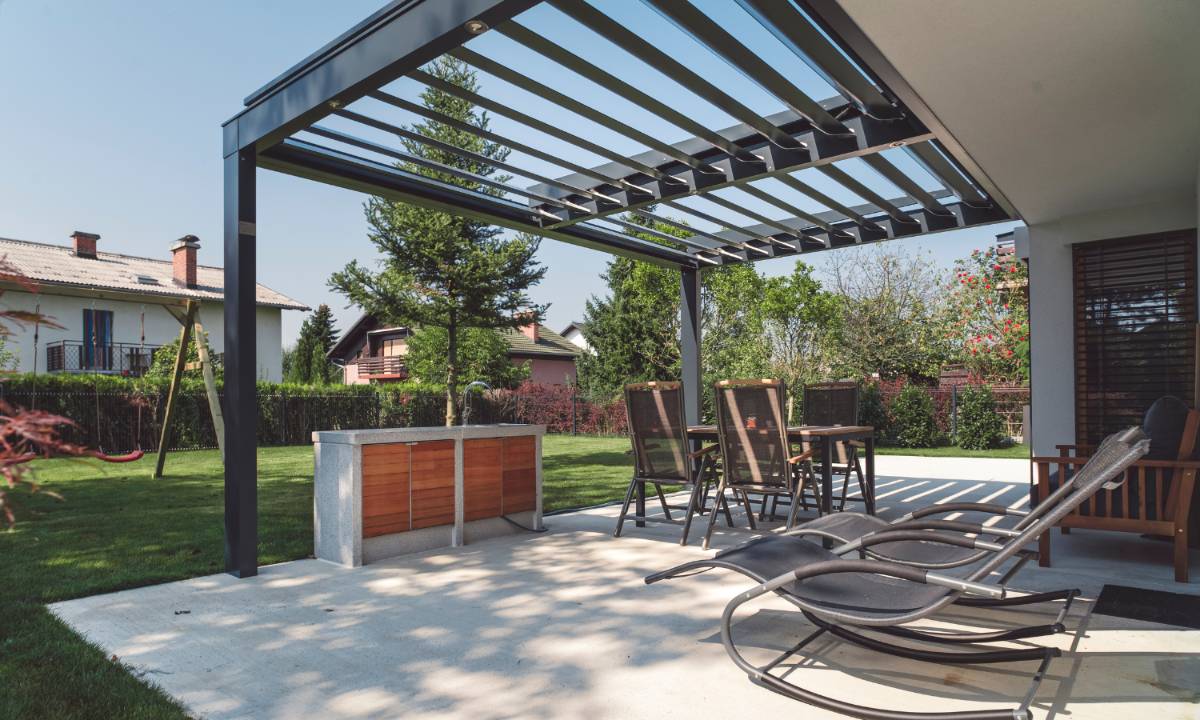
Know About The Basics of Pergolas Before Building One
Before embarking on your pergola project, let’s explore the fundamental steps to ensure your endeavor is a resounding success:
- Pergola Purpose: Begin by determining the pergola’s primary role in your outdoor space. Is it for shade, ornamental beauty, or a cozy outdoor living area? Understanding its purpose will be your guiding star in both design and material selection.
- Location and Design: Scout your yard for the perfect spot, factoring in considerations like sunlight, prevailing wind direction, and proximity to your home. The pergola’s design should harmonize with your landscape and the architectural style of your house.
- Materials: Carefully choose the building materials, considering your budget and aesthetics. Options range from natural wood, sleek vinyl, to sturdy metal. Ensure your choice is durable and can withstand the elements.
- Building Regulations: Check local building codes and regulations. Depending on your area, you might need a permit for your pergola project to avoid any unexpected roadblocks.
- DIY or Professional Installation: Decide if you’re up for a DIY challenge or prefer the expertise of professionals. DIY plans are available, but for a sturdy and well-constructed pergola, enlisting experts can be a wise choice.
By thoughtfully considering these factors, you’ll be well-prepared to craft a pergola that not only fulfills your needs but also elevates the charm of your outdoor space. As you embark on this journey, remember that a pergola, whether it’s a standalone structure or an extension of your home, can be a versatile canvas for enhancing your outdoor living experience. In snowy climes, planning for winter resilience or even a cozy heating system will ensure year-round enjoyment without compromising its elegance.
Conclusion
In this article, we have discussed the basics of pergolas for you to know about before deciding to build one. We hope you know pergolas and how to use them in your backyard or front porch. If you’re looking forward to building your pergola, follow this guide and start immediately.

